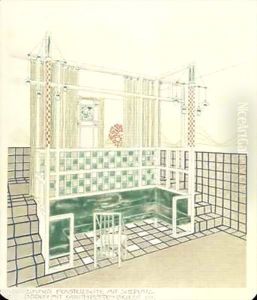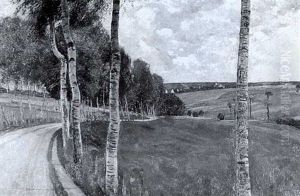Leopold Bauer Paintings
Leopold Bauer was an Austrian architect, born on April 1, 1872, in Mährisch-Schönberg, now Šumperk in the Czech Republic, which was part of the Austro-Hungarian Empire at the time. He was active during the late 19th and early 20th centuries, a period that saw significant changes in architectural styles and preferences, transitioning from historicism to modernism.
Bauer studied architecture at the Technical University of Vienna under Karl König and Carl König, and later at the Academy of Fine Arts Vienna under Otto Wagner, who was a leading figure in the Viennese Secession movement and a pioneer of modernist architecture. Under Wagner's influence, Bauer would go on to develop a style that combined functionalism with the aesthetic qualities of the Vienna Secession.
Throughout his career, Bauer designed a variety of buildings, including residential, commercial, and public structures. His work was marked by a careful attention to detail and a tendency to blend traditional forms with new, innovative design concepts. He was also interested in urban planning and was involved in the design of several urban projects. Bauer's work contributed to the evolution of modern architecture in Austria and the broader Austro-Hungarian region.
Some of Bauer's notable projects include the Villa Bauer in Mödling and the conversion of the Palais Erzherzog Wilhelm into the Café Herrenhof in Vienna. His designs often featured elements such as geometric forms, the use of new materials like reinforced concrete, and an emphasis on functionality.
Leopold Bauer's career was also marked by his involvement in teaching. He was a professor at the German Technical University in Brno, where he influenced a generation of architects with his ideas and methodologies. Despite his influence on modern architecture, Bauer is not as widely recognized as some of his contemporaries.
Leopold Bauer died on September 9, 1938, in Vienna, Austria. His legacy lives on through his contributions to architectural design and education, and his works remain as examples of the transition from the ornate styles of the 19th century to the more stripped-down and functional designs that characterized early 20th-century modernism.


